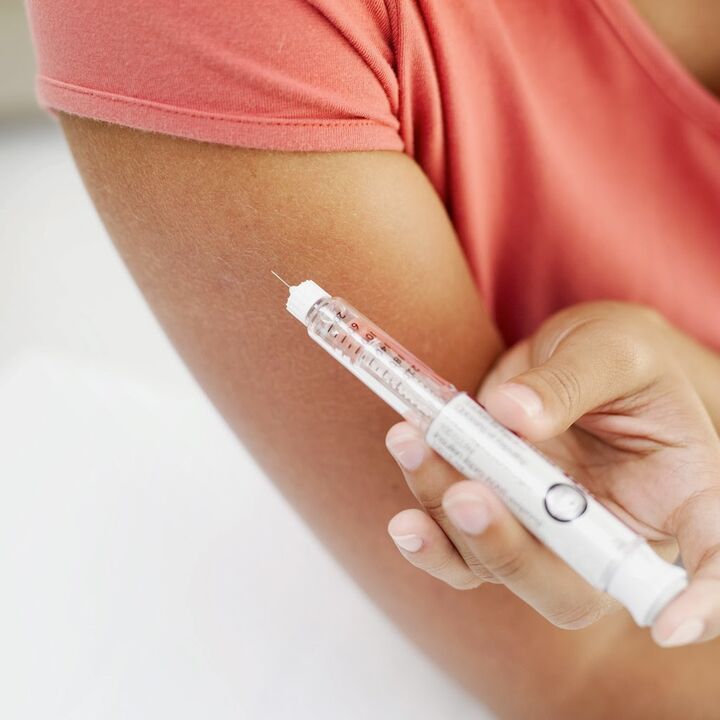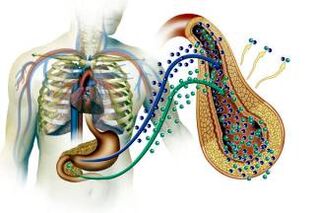Diabetes mellitus is a serious disease, characterized by insulin deficiency at one degree or another. As a result of pathology, hyperglycemia may occur, which is an increase in blood sugar, which leads to a variety of metabolic disorders and complications.
Diabetes is third in the prevalence after cancer and cardiovascular disease. Worldwide, more than a hundred million people with the disease are now known. Every 15 years, the number of doubles cases.
Drugs that can eliminate manifestations of diabetes do not exist. If the disease is not treated for a long time, then irreversible disorders in various organs occur.
To see the pathological symptoms in time, you need to know what kind of diabetes exists.
Type of diabetes

In medicine, several types of diabetes are released. The term itself reveals the entire list of diseases with general features. The features of diabetes and their type are made up of blood sugar pathology.
There are many reasons why insulin cannot cause glucose to cells from the blood. However, the results are always the same: with strong blood saturation with sugar, cells cannot be eaten normally.
When the sugar does not fall into the cell, it pulls water on it. The fluid filling the blood flow through the kidneys, and dehydration occurs. Although diabetes exists, there are such symptoms:
- Dry mouth.
- Thirst.
- Frequent urination and abundant.
Each type of disease is distinguished by its own characteristic effects on the human body. Diabetes, its type has its own difference, perhaps:
- Nonachary and sugar.
- Latent.
- Potential, it is expressed in the tendency of the disease.
- Insulin -depending on and insulin -dependent.
- Laby.
- Kidney.
- Postoperative, it appears after surgery in the pancreas.
- The pancreas, expressed in pancreatic wounds.
- Not -pancretical, it is not associated with damage to the pancreas.
The first type of diabetes mellitus

Insulin -Diabetes is called autoimmune or virus damage to the pancreas, an organ that produces insulin. People with type 1 diabetes, insulin either do not have at all, or they are in very small quantities.
Statistics suggest that type 1 disease appears at a young age. It is determined by symptoms such as frequent thirst, fast urination, rapid weight loss, strong hunger and acetone appearance in the urine.
The treatment of various diseases is to introduce the desired dose of hormone from the outside. Other therapeutic actions are ineffective. The first type of diabetes appears most often due to genetic tendencies. Such diseases can trigger one or more negative factors, initiating pathological changes in the immune system.
As a result, the pancreatic cells are defective, producing insulin. Hormone deficiency leads to the fact that carbohydrates cannot be completely disposed of in the body, and lack of energy trying to make fat processing.
Toxic substances begin to enter the brain. Therefore, it is very important to constantly control the condition of the body and the glucose content in the blood.
The disease may occur because of:
- Infection.
- Pressure.
- Sed by a lifestyle.
- Autoimmune disease.
- Descent.
- Inal food.
Such diabetes is up to 15% of the total patient. Usually, children and teens are sick. The disease arises due to the passive lifestyle, and the use of carbohydrates continues. Obesity and diabetes can appear while taking:
- Soda drink.
- Smoked meat.
- Canned products.
- Fast food.
Sometimes diabetes, and then obesity begins. Type 1 disease has such symptoms:
- Disadvantages.
- Irritation.
- Feeling tired.
- Nausea.
- Improved wear.
- Call to urinate.
Often patients quickly lose weight, or vice versa. Diabetes can:
- Main: genetic, important.
- Secondary: thyroid, pituitary, steroid.
The disease can be mild, simple or serious. By the nature of this course, the disease is divided into insulin and insulin -dependent types. Due to the high sugar content in the blood, buds and blood vessels defective.
Therefore, people suffering from type 1 disease, in many cases, lose their vision, become almost blind. There are also two main manifestations: the first kidney violation, then - failure of this organ. Often patients note the pain and numbness of the limbs. This is due to infarction of blood circulation and damage to the nerves.
If it violates blood flow to the legs, there is a high risk of foot amputation. With type 1 disease, there is a high amount of cholesterol in the blood, therefore, in diabetics, cases of stroke or unusual myocardial infarction.
In men with diabetes, impotence often develops, as nerves and blood vessels stop existing in a healthy regime. Because of the pathology, they appear:
- Obesity.
- Pancreatitis.
- Dermatopathy.
- Nephropathy.
- Encephalopathy.
One of the pathologies that poses a huge danger is hypoglycemic commas. This condition often causes death.
Patients with diabetes should determine daily blood sugar levels using special devices made for home conditions. If necessary, urine is prescribed for sugar content.
If glucose levels increase, then insulin injection is required to treat 1 type disease. These hormones are involved in metabolism, which allows the body to process carbohydrates.
If there is no sufficient type 1 diabetes treatment, serious complications arise. In some cases, death is possible. Sometimes a person needs hospitalization to create the complexity of the situation.
In stationary conditions, patients are taught new sugar control skills.
The second type of diabetes mellitus

This type of disease occurs with inadequate insulin products by the pancreas. This condition is also aggravated by the decline in the activity of the organ cells. Usually, pathology is formed due to a decrease in non -consuming tissue to hormones.
The fabric subject to insulin has an insulin receptor. Due to the appearance of the pathology of this receptor, tissue immunity to insulin develops. Hormone secretion does not decrease, forming relative insulin deficiency.
In patients with obesity, first of all, there is a decrease in insulin receptor function. Overflow leads to excess glucose formation in the blood, while non -controversial tissues do not allow it to obtain glucose into the cell.
Because sufficient amount of insulin is required to get sugar into the cell, excess products from the pancreas begin, which are wrapped in fatigue of beta cells.
2 types of diabetes in the field of medicine are not considered a pathology of hereditary, but a bad lifestyle disease. Even with severe descent, such a violation will not be formed if:
- The use of other "fast" sweet "carbohydrates is limited.
- Don't eat too much.
- There is continuous control over the body mass.
- Physical training is always done.
Symptoms of type 2 diabetes are not specific. The person does not see their manifestations, in most cases, as there is no significant deterioration in well -being. But knowing the symptoms, you cannot miss their appearance and consult your doctor on time, determining the concentration of glucose in the blood. Therefore, successful compensation for diabetes will be created, the risk of complications will decrease significantly.
The main manifestations of this pathology:
- Dry mouth.
- An increase in the amount of urine, which makes one always wake up at night.
- Strong thirst.
- Itching -itching of the mucous membrane.
- Strong taste related to failure of leptin synthesis.
The presence of diabetes can also speak:
- Slow wound recovery.
- Furunculosis.
- Deadly.
- Fungal infection.
The disease is available for the first time when entering the hospital due to stroke or heart attack. Such a disease indicates that diabetes is in a serious level.
Common symptoms are only indicated by increased sugar levels above the kidney threshold - 10 mmol /l. With this increased glucose, it appears in the urine. If the value does not reach 10 mmmol/l of blood, then one does not feel the change in the body.
It can be noted that random installation of type 2 diabetes is a very common phenomenon.
For diabetes therapy, 2 types are used: the following methods are used:
- Biguanides.
- Thiosolidindo.
- Sulfanillarochevina cost.
- Clay.
Gestational diabetes
This form of pregnancy can appear in pregnant women. Pathology is formed due to inadequate insulin production, which is required to control blood sugar.
During pregnancy, the female body is forced to produce a large amount of insulin, which provides fetal needs. This process is very relevant in the second half of children.
If there is insulin deficiency, the blood glucose level continues to increase, giving the opportunity to form a type of pregnancy diabetes. The disease usually occurs independently, immediately after giving birth.
This is a feature that distinguishes it from other types of diabetes, chronic.
Latent diabetes

A large number of unclear moments are associated with diabetes. The most common types of diseases are the first and second types. Keep in mind that there is a middle type of this dangerous disease called pepper diabetes.
Such a disease occurs in adulthood. Various diseases are dangerous for a long time it can be disguised as type 2 diabetes. The latent form of the disease is very difficult.
Pepper is a serious autoimmune disease. The immune system begins to attack its own organisms, constantly destroying beta cells that produce insulin in the pancreas. But such patients can be done without insulin injection for a long time, unlike those who are more type 1 diabetes.
With the form of diabetes, the immune process runs slowly. In the pancreas, work beta cells are preserved. Patients show treatment with medications intended for diabetics with diabetes. Over time, antibodies destroy more beta cells, leading to a serious decline in the amount of insulin and the inevitable use of insulin therapy.
Hidden diabetes
Hidden diabetes mellitus has another name: latent or sleeping. This pathology was diabetes in the early stages.
With the early stages of diabetes, sugar and blood indicators never exceed the norm. In the early stages of the disease, a violation of glucose tolerance was recorded. Further, after the load of sugar, one is noted in the blood very slowly, but decreases the glucose concentration.
People like this have a relatively high probability of diabetes in 10-15 years. The disease does not require certain complex therapy, but ongoing medical observation is important. The latent type of diabetes mellitus can occur for years.
To develop it, sometimes enough to survive in serious nerve disorders or to get a viral infection.
Diabetes is not -adalar
Non -adalar diabetes is a pathology, which is caused by absolute or relative vasopressin, hormone, which has antidiuretic effects. People suffer from urine and thirst. Sleep is significantly damaged, and one usually cannot restore strength.
About 6-15 liters of loose, light urine is released daily. There is also a lack of appetite and weight loss. One is always tired and irritated, dry skin and lack of sweating are observed.
Subcompensated diabetes
Diabetes mellitus is a disease consisting of impaired carbohydrate metabolism. All medical measures are intended to normalize it. It is a bit difficult to achieve a solid effect. Due to prolonged therapy, the level of carbohydrate metabolism can change and have different values.
There are several forms that allow you to balance this dangerous disease. We're talking about:
- Decompensated.
- Subcompensated.
- Form of compensation.
The decompensated form is characterized by the fact that there is almost no increase in carbohydrate metabolism. There is a high concentration of glucose in the blood, acetone and sugar found in the urine.
Subcompensated diabetes is a pathology in which blood sugar is not very different from the norm, there is no acetone in the urine. With the compensation of the disease, one has glucose in normal conditions, while there is no sugar in the urine.
Laby diabetes
The disease can be distinguished by the nature of the course for stable and stable. The type of Labil disease is characterized by significant glucose fluctuations in the blood daily.
In people like that, hypoglycemia appears, most often with dinner. Last night and early morning there was a strong thirst and hyperglymp. The hidden course of the disease is often accompanied by the formation of ketoasidosis, which often leads to diabetes coma.
Hyperglycemia hypoglycemia replacement is a feature of youth and childish diabetes. Travel stability The disease is a feature of average level. The disease continues Labilly when it is severe.























